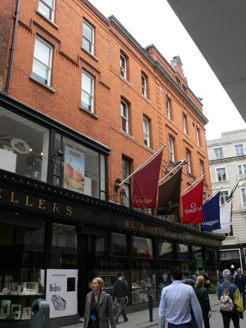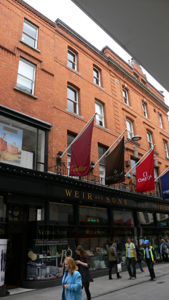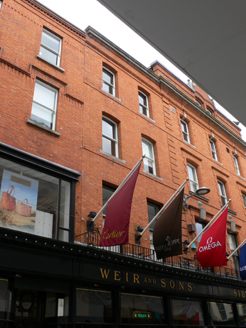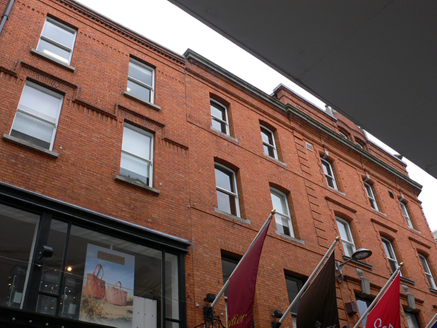Survey Data
Reg No
50910113
Rating
Regional
Categories of Special Interest
Architectural, Artistic
Original Use
Shop/retail outlet
In Use As
Shop/retail outlet
Date
1875 - 1885
Coordinates
315955, 233888
Date Recorded
10/05/2016
Date Updated
--/--/--
Description
Attached two-bay four-storey commercial premises, built c. 1880, with shopfront to ground floor. In use as jewellers shop. Pitched roof behind moulded brick parapet with moulded limestone cornice. Red brick walls with brick platbands between upper floors, and with rusticated brick pilaster quoins to east end of facade. Square-headed window openings to first floor and camber-arch to floors above, with flush limestone sills and one-over-one pane timber sliding sash windows. Shopfront extends across neighbouring building to east, having continuous moulded and painted fascia with raised lettering 'Weir and Sons/Silversmiths', surmounted by moulded modillioned cornice, and topped with decorative iron railings. Timber display windows with overlights, subdivided by timber colonnettes (some faced with steel pieces) over polished black granite stall-riser. Early to mid-twentieth-century awning arms retained. Square-headed door opening with timber and bevelled glass door, having brass handles and decorative frosted glass to lower section with lettering 'Weir & Son Manufacturing Silversmiths Jewellery/Showroom Grafton St'. Door set within moulded timber frame with carved timber swan's-neck pediment, and having multiple-pane timber overlight with keyed oculus to centre, and shouldered timber architrave. Well-preserved interior, including plasterwork ceilings, frosted mirrors, and freestanding oval display cabinets of c. 1935.
Appraisal
The stretch of Grafton Street between Wicklow and Suffolk streets was almost entirely rebuilt about 1881 to the designs of W.M. Mitchell, forming a cohesive commercial block at Nos. 96-100 and 105-6. Weir & Sons, jewellers, moved into the premises (Nos. 96) about 1905, and the ornate timber doors from their former premises were relocated to the principal entrance on the Wicklow Street (south) elevation. Alterations during this time were carried out to the designs of Batchelor & Hicks. Nos. 97-99 was replaced in the 1930s by George L. O’Connor's Maskora Turkish Baths, but this Art Deco design is successfully book-ended by Mitchell's remaining blocks. No. 96 is well retained and effectively addresses the prominent corner site between Grafton and Wicklow streets. The group is linked by a good wraparound shopfront and the interior of No. 96 contains a number of notable features, including oval freestanding display cases by Pollard & Co. of London, c. 1935.







